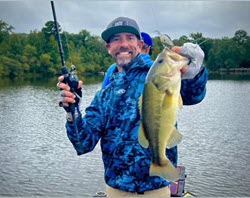
A spinnerbait is a very simple contraption – a combination of wire, a head, a hook, and some blades – but it’s one of the most effective lures ever created. Why is it so good and so universal? Because most lures appeal to only one of a fish’s senses, but the spinnerbait appeals to all five. In the water, it provides multiple reasons for bass to strike – flash, vibration and visual attraction. Bass are sight feeders; even in crystal clear water, a spinnerbait looks like a school of baitfish.

Blade Type is your starting point when you pick a spinnerbait. It can be confusing:
- Round blades, called Colorados, produce the most vibration, so I use them in dirty or muddy water or low-light conditions.
- Willow blades, with their elongated blades, produce more flash but less vibration. I use them in clear water and/or bright skies.
- Teardrop blades, known as Indiana blades, are in-between the two. They provide some flash and vibration, so they’re good for middle-of-the-road conditions or when you’re not sure what to use.
You need to consider three other things when you choose your blade type:

Cover: Usually, for “soft” cover like grass or pads or bullrushes I prefer willow blades because they slip through the cover better. Around hard cover like docks and stumps, I want to make contact, so a Colorado can be a better choice. When there’s a mix of cover, an Indiana gets the nod.
Water temperature: In the simplest terms, the colder the water the more likely I am to go round. I want to slow the bait down and attract the fish with a hard thump. When it’s hot, I go for the willows, and when it’s in-between, the Indiana once again gets the call.

Blades Setup: When vibration is the only thing I care about, a big single-blade is the deal. When I want maximum flash, I’ll use what we call a “double” – two blades of the same type, often willows. My favorite, though, is the tandem, which consists of two different blades. It’s the best of all worlds, the workhorse of spinnerbait fishing.
Once you’ve picked out the blade types and setup, you need to consider:
SIZE. Size is determined by the forage and the depth of the water you’re fishing. I use everything from little 3/16 ounce spinnerbaits for shallow water to the big one-ounce-plus spinnerbaits called “Ledgebusters” for deep water, and everything in between.
To pick the right size, (1) match the size of the spinnerbait to the baitfish the bass are feeding on and (2) match the weight of the spinnerbait to the depth of water. It’s possible to fish spinnerbaits in water from less than a foot deep down to 40 feet, and , as a general rule you want to increase the weight of your spinnerbait to maintain bottom contact, even if you’re not fishing the lure on the bottom.

Color Patterns. You also need the proper color patterns. Once again, two factors come into play: forage and water clarity. When I’m fishing around little shad, I might use a translucent skirt and silver blades. If there are more bluegills in the area, I might prefer gold blades and a skirt that includes green pumpkin, yellow, blue, and/or orange. Yellow perch are best matched with fire tigers.
The general rule is that in clearer water I’m more likely to use lighter and more translucent colors and silver blades. In muddier water I want some more vibrant colors. There are also some sleeper colors. The first includes what I call “hot blades” – solid white, chartreuse, orange or even pink. These provide a weird anomaly because they’re great for maximum visibility in dirty water, but they can also excel in extremely clear water. Fished very fast, they’re great in the clear stuff for schooling fish, smallmouths or spots. I also like some dark spinnerbaits, usually black or black and blue, for fishing in low light, stormy conditions, or at night.


Add-Ons. Spinnerbaits may benefit from certain add-ons. The first is soft plastic trailers. While a wide range of soft plastics will work, I really like a single-tail grub. It provides bulk and allows me to slow the lure down while giving it great action. I’m most likely to add on the grub in cold or muddy water, and when those two conditions converge, it’s a must.

Trailer Hook. Finally, I use a trailer hook about 70 percent of the time to garner extra hookups. I may take it off in heavy cover, when it’s snagging too much, or when using a short arm spinnerbait, but otherwise I like the assurance it gives me. I’m convinced that it results in more fish in the boat. Just make sure that you don’t overpower your lure with an oversized trailer hook and that you always rig it in the same direction as your spinnerbait hook so it’ll come through the cover cleanly.
________________________________________________________________________


_____________________________________________________________
Like Ike on Facebook, and follow him on Instagram and TikTok for fishing and fun content.
Subscribe to Mike’s YouTube channel, to ensure you see every adventure video. (Download the YouTube app on your phone and the videos will come to you automatically.)
Return to Mike Iaconelli’s website
















